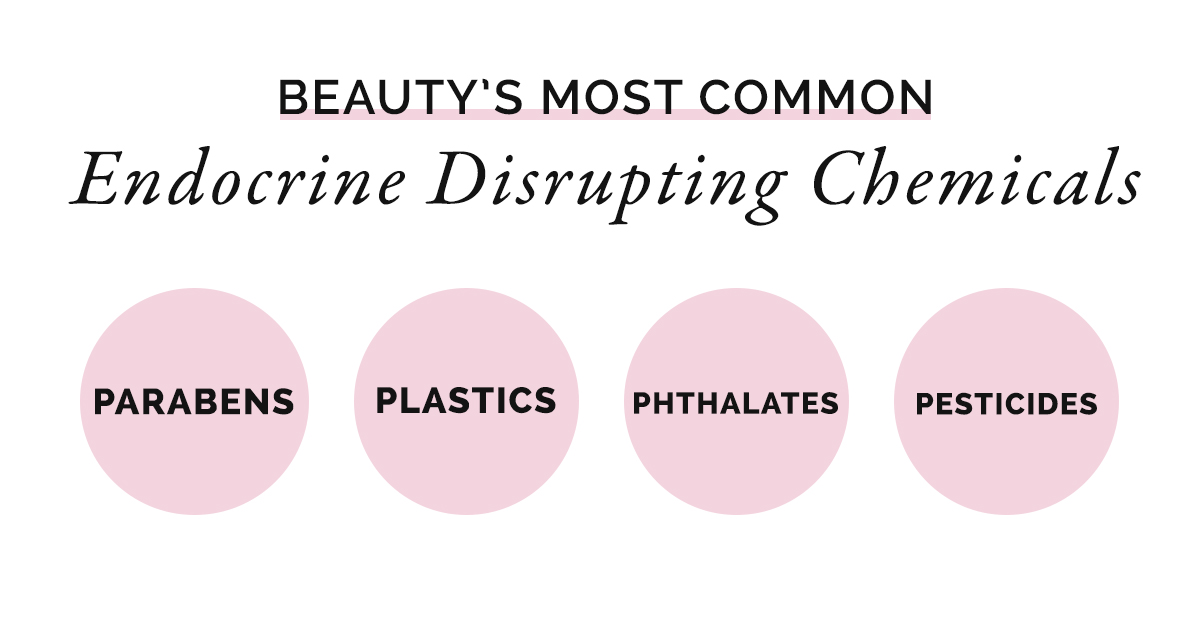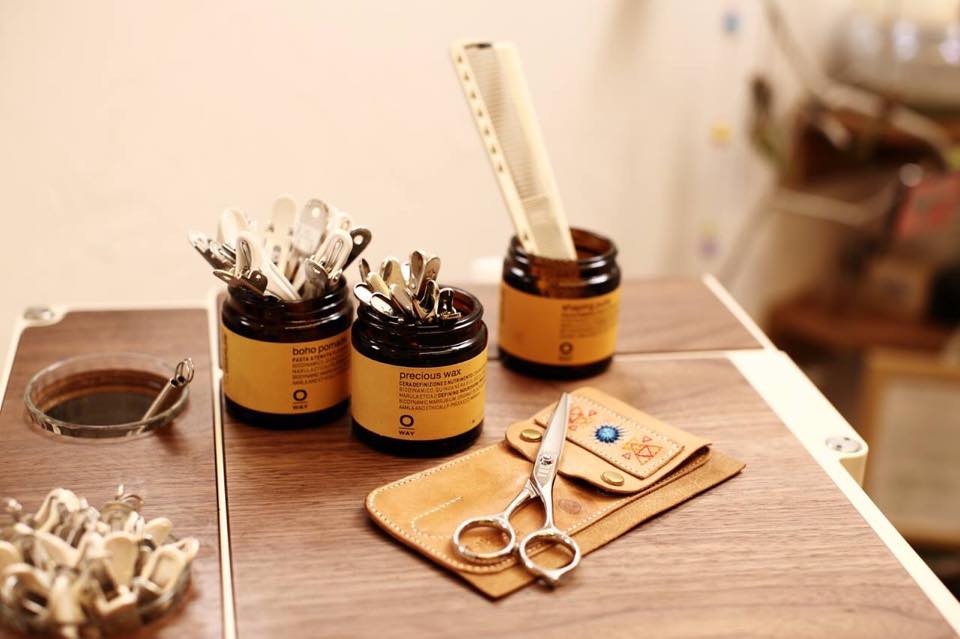Endocrine-disrupting chemicals or EDCs, can be one of the most difficult chemicals to avoid in beauty products. They cleverly elude most ingredient lists by hiding within a product’s packaging or an ingredient itself. So, how can we avoid these harmful chemicals if we can’t find them?
Don’t worry. By the end of this article, you’ll learn how to identify and avoid endocrine-disrupting ingredients and why it’s important to limit our exposure to these harmful hormone-mimicking chemicals.
What are Endocrine-Disrupting Chemicals (EDCs)?
According to the UK’s BreastCancer.Org, an endocrine disruptor is any chemical that can interfere with normal hormone functions in humans or animals. While there are naturally occurring types found in plants, such as soy (known as phytoestrogens), most endocrine-disrupting compounds come from synthetic chemicals and can be avoided.
Why Should We Avoid Endocrine Disruptors?
There’s seemingly no end to the adverse health impacts of endocrine-disrupting chemicals.
Also known as EDCs, these tricky chemicals can imitate hormones and destroy others while creating internal signaling issues which causes premature cell death. Endocrine disruptors have also been proven to accumulate in hormone-producing organs, resulting in organ malfunctions and irreversible damage.
So, how does this hormone disruption manifest itself in humans, exactly?
Endocrine-Disrupting Chemicals Linked to Increased Breast Cancer Risks
Once thought to only effect hormone-regulating organs, research now clearly demonstrates that the mechanisms of EDCs are much broader than originally recognized. Of prominence is the growing relationship identified between EDCs and cancers, including in the breast, and common diseases like cardiovascular, pulmonary or neurodegenerative disorders to name a few. [1]
Breast and uterine cancer are the most frequent female-related cancers whose growth is mostly estrogen dependent. Therefore, any EDC exhibiting estrogenic effects may increase the risk of these two malignancies. [2]
Endocrine-Disrupting Chemicals Linked to Depression, Autism and Neural Degeneration
Because certain EDCs are able to alter neural transmission and the formation of neural networks, the term neural-disrupting chemicals has been introduced, thus implicating EDCs in the cause of neurological disorders.
Recently, public concern has been focused on the effects of EDCs on brain function with an increase in neuropsychiatric disorders, including autism, attention deficit and hyperactivity disorder as well as learning disabilities and aggressiveness. Several lines of evidence suggest that exposure to EDCs is associated with depression and could result in neural degeneration.
How to Avoid Endocrine-Disrupting Chemicals in Cosmetics
As you can see, the detrimental effects of endocrine-disrupting chemicals are becoming widely recognized in both the health, wellness and medical communities, now it’s time to transfer that knowledge to the beauty industry.
Here’s where you’ll find potential endocrine-disrupting chemicals lurking in your beauty products and most importantly, how to avoid them.

Parabens
By far one of the most controversial endocrine-disrupting chemicals is parabens. Commonly used as inexpensive preservatives, these synthetic chemicals are proven to mimic estrogen in the human body and have been found built up in essential hormone regulating organs.
Parabens are chemicals with estrogen-like properties, and estrogen abnormalities are involved in the development of breast cancer. In fact, a 2012 medical study confirmed our suspicions that endocrine-disrupting chemicals can increase risks of breast cancer.
The study found 99% of malignant breast cancer tumors contained 1-5 different types of parabens.[4]
The US Environmental Protection Agency (EPA) has even linked methylparabens, in particular, to metabolic, developmental, hormonal, and neurological disorders, as well as various cancers.
Unlike many endocrine-disrupting chemicals, parabens can be found in the product’s ingredient list. Here’s what to look for.
List of Paraben Types to Avoid:
- Methylparaben
- Butylparaben
- Propylparaben
- Ethylparaben
- Isobutylparaben
- Benzylparaben
Plastic Packaging
When it comes to EDC exposure, our most widespread threat may be plastics. They’re everywhere, wreaking havoc in our oceans, food containers and no doubt sitting on the shelf of your shower.

The problem with plastic packaging is its ability to leach harmful chemicals into the material it contains. Currently, the most widespread concern is the manmade chemical, Bisphenol-A or BPA – a widely recognized endocrine-disrupting chemical and xenoestrogen.
What Are Xenoestrogens?
A xenoestrogen is a hormone-mimicking chemical in humans and animals, specifically the hormone, estrogen.
Not only has BPA been linked to endocrine disruption, but environmental scientists have noted its detrimental effects on our oceans and wildlife. Recall, xenoestrogens and EDCs don’t just affect humans, but the delicate plants and animals comprising our vital ecosystems.
So, just avoid BPA, and you’ll be fine, right? Not necessarily.
This study from Environmental Health Perspectives, uncovered a very telling discovery.
“The testing showed that more than 70 percent of the products released chemicals that acted like estrogen. And that was before they exposed the stuff to real-world conditions: simulated sunlight, dishwashing and microwaving.”
It’s very difficult to avoid all plastics in everyday life, but as conscious beauty professionals, we can start behind the chair by replacing plastic products with amber glass salon products.
Phthalates
Pronounced thal-ates, phthalates are one of those elusive endocrine-disrupting chemicals you won’t see directly spelled out on a cosmetic’s ingredients list. Unlike our other aforementioned compounds, phthalates do not have hormone-mimicking effects on the body. Instead, studies have shown adverse effects on the male reproductive system, including decreased sperm count, testicular cell destruction and thyroid irregularities.
How to Avoid Phthalates:
- Look for beauty products without synthetic fragrance
- “Fragrance” or “pafum” could be the most vaguely listed ingredients in existence. Because fragrance is considered “proprietary,” companies are not required to disclose its components. This is where sneaky ingredients, like phthalates, can make unknowingly make their way into your products.
- Avoid plastic packaging, especially PVC with recycle code #3.

Pesticides
Pesticides in beauty products? You might be thinking, that can’t possibly be a listed ingredient and you’d be correct. While we can all appreciate the rise of more natural beauty products, we should be cognizant of the type of plants used in our cosmetics and how they’re harvested.
Specifically, neurotoxic organophosphate compounds were developed during WWII by Nazis as nerve gas to aggressively attack the human nervous system. This same chemical has been adapted for pesticides to target the nervous system in bugs and pests.
How to Avoid Organophosphates:
- Purchase professional organic salon products.
- Specifically, look for the botanical ingredients to be organic (grown without pesticides) or biodynamic-organic (a step above organic).
- Purchase raw organic fruit and vegetables, if using natural beauty treatments.
While it may be impossible to avoid all endocrine-disrupting chemicals in our beauty products, steering clear of questionable ingredients like Parabens, Phthalates, Plastics, and Pesticides is a big step in limiting our harmful toxin exposure. Even though the beauty industry is highly unregulated, together, we can make informed, conscious decisions to ensure the health, wellness and beauty of ourselves and salon clients.
So the next time you’re tempted to purchase a new product, make sure to look out for these 4 major endocrine-disrupting chemicals. Your health, your clients, and the planet will thank you for it.





